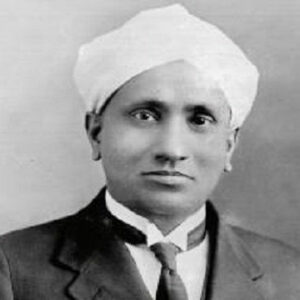Sir Chandrasekhara Venkata Raman, the Indian physicist who created history by becoming the first Indian to earn the Nobel Prize in Physics, was a brilliant scientist. Even as a child, he demonstrated a brilliant mind and passed his matriculation examination at a far younger age than other students. Raman was raised in an academic milieu as the son of a mathematics and physics lecturer. He was a great student throughout his academic career and was passionate about research; in fact, he began working on optics and acoustics research while still a student. Despite the fact that he began his work as a Deputy Accountant General, he could not stay away from research, frequently staying up all night to learn new things in the field of physics. He was fascinated by the blue color of glaciers and the Mediterranean Sea, and he wanted to know why water, a colorless liquid, seemed blue to the naked sight. Thus began a series of studies on light scattering that eventually led to the discovery of the ‘Raman Effect,’ for which he was awarded the Nobel Prize in Physics.
Childhood and Adolescence
R. Chandrasekhara Iyer and Parvathi Ammal raised him in a small village near Tiruchirapalli. His father, who began his career as a schoolteacher, went on to become a lecturer in mathematics and physics at a Vishakhapatnam college.
Raman attended Vishakapatnam’s St. Aloysius Anglo-Indian High School. He was an outstanding student who completed his matriculation examination at the age of eleven. He received a scholarship after passing his F.A. exams (equivalent to today’s intermediate examination) at the age of thirteen.
In 1902, he enrolled at Madras’ Presidency College and graduated with a B.A. in physics in 1904. He ascended to the top of the tests and was awarded a gold medal. In 1907, he received his M.A. after three years of study.
Career of C.V. Raman
Despite his strong interest in science, he took the Financial Civil Service (FCS) examination at his father’s request. He aced the exam and was hired as an Assistant Accountant General by the Indian Finance Department in Calcutta in 1907.
His heart remained in scientific research, and in his spare time he began undertaking research at the Indian Association for Cultivation of Sciences. His job was demanding, but he was so committed to science that he regularly stayed up late doing study.
Despite the fact that the association’s facilities were severely constrained, Raman went on to publish his discoveries in prestigious international journals such as ‘Nature,’ ‘The Philosophical Magazine,’ and ‘Physics Review.’ During this time, his main scientific interests were vibrations and acoustics.
In 1917, he was offered a position as the first Palit Professor of Physics at the University of Calcutta. Raman gladly resigned from his government job to take this one, despite the fact that the new job paid far less than the prior one. His commitment to science was unwavering.
He was appointed Honorary Secretary of the Indian Association for the Cultivation of Science in 1919 and retained the position until 1933. He was exceedingly well-liked, and many pupils flocked to him, drawn by his vast scientific knowledge.
He studied the dispersion of light in the late 1920s by analyzing the behavior of monochromatic light that passed through transparent materials and landed on a spectrograph. This led to the discovery of the so-called “Raman Effect,” which he presented at a scientific symposium in 1928.
The Indian Institute of Science (IISc) in Bangalore invited him to become its Director. In 1933, he accepted the position, making him the first Indian to occupy it. He was the director until 1937, after which he became the head of the Physics Department until 1948.
He founded the Raman Study Institute (RRI) in Bangalore in 1948 to perform scientific research in a variety of physics topics. He worked at the institute until his death, continuing his study.
Major Projects of C.V. Raman
He is most recognized for discovering the ‘Raman Effect,’ or inelastic photon scattering. Experiments revealed that when light passes through a transparent medium, some of the deflected light changes wavelength. In early twentieth-century physics, this was a game-changing finding.
Achievements & Awards
He was the first Indian to win a Nobel Prize in the sciences when he earned the Nobel Prize in Physics in 1930 “for his work on light scattering and the discovery of the Raman Effect.”
In 1954, he was awarded the Bharat Ratna, India’s highest civilian accolade, in appreciation of his outstanding contributions to science.
Personal History and Legacy
In 1907, he married Lokasundari Ammal and they had two sons, Chandrasundari and Radhakrishnan.
He lived a long and fruitful life and remained active till the end. At the age of 82, he died in 1970.
Estimated Net Worth
CV is one of the wealthiest physicists and one of the most well-known. CV Raman has a net worth of $1.5 million, according to Wikipedia, Forbes, and Business Insider.
Trivia
This brilliant scientist was the paternal uncle of Subrahmanyan Chandrasekhar, another great scientist and Nobel laureate.


